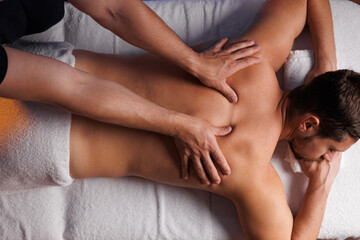Massage therapists manipulate their clients’ soft tissues and joints to treat injuries, alleviate pain, and promote general wellness. They use lotions, oils, and specialized tools to deliver therapeutic massages.

In states that regulate the profession, massage therapist needs to complete their education and pass an exam. They also need to gain experience and build a client base. To learn more, visit https://www.flowstate918.com/.
While many people think of massage as a luxurious part of a spa day or as something they do to pamper themselves, it has long been recognized as a useful tool in helping balance the mind and body. Medical doctors and physical therapists often recommend it as part of a health care plan to reduce pain, anxiety, and other conditions.
A variety of health benefits are attributed to massage therapy, including decreasing stress and anxiety, easing the symptoms of fibromyalgia, and improving sleep quality. Some studies have even shown that it can lower blood pressure and boost serotonin levels, which contributes to a healthier mood.
One reason it may help to lower stress and anxiety is because massage triggers the body’s parasympathetic nervous system, which focuses on routine and daily operations that lead to relaxation and rest. This helps decrease feelings of stress and also lowers cortisol levels, which are associated with depression.
For people with chronic or acute pain, massage is an effective treatment. It can ease the pain of fibromyalgia, arthritis, muscle soreness after exercise or from participating in sports, and back and neck pain. It can also help alleviate the discomfort of a migraine, headache, or the side effects of some cancer treatments.
It can also improve flexibility and range of motion in joints and soft tissues. And it can help prevent injuries by increasing circulation and reducing stiffness and tightness in muscles and joints. Massages can also assist with postural realignment, restoring proper alignment of the body.
There are a number of different massage techniques, and you should choose a program that exposes you to a variety of them. This will give you the opportunity to find a technique that works best for you and your clients. For example, some modalities include deep tissue massage, shiatsu, hot stone and reflexology.
As you work to develop your skills, it is important to communicate effectively with your clients and listen to their needs. This will enable you to create a treatment plan that is most beneficial for them and ensure their safety. You must also maintain accurate and confidential client records.
Education and Training
A massage therapist needs training before they can start their career. The majority of massage therapists earn a post-secondary certificate. Typically, these programs are offered by vocational schools and community colleges. Programs often combine in-class studying with hands-on practice to help prepare students for the workplace. Students should find out what the school’s educational philosophy is before they enroll. For example, some schools may place a greater emphasis on the role of massage therapy as part of an overall healthcare approach, while others are more focused on scientific methods and evidence-based approaches to massage.
After graduating, massage therapists can find work at hospitals, resorts, spas and private offices. Some therapists choose to pursue a higher degree, which can open more employment opportunities and lead to a higher salary.
Typical coursework for a massage therapist degree includes classes like anatomy, which covers the structure of the body; kinesiology, which studies how the body moves; physiology, which describes how different parts of the body function; and pathology, which tests students’ knowledge of diseases and conditions that can be affected by massage. Most programs also include courses on professional ethics and massage modalities.
Massage Therapy Association is an organization for massage therapists and a good resource for those interested in learning more about the field. This group provides leadership training, networking events and information about the latest advances in massage techniques and research.
Many states require massage therapists to pass a licensing exam before practicing their craft. In order to take the exam, a candidate must have completed a certain number of hours of training, which varies by state. Normally, these hours are earned through a massage therapy program, but they can be obtained through multiple schools.
Licenses and Certifications
If you dream of becoming a professional massage therapist, you’ll likely have to get licensed to practice. Similar to how a physical therapist or chiropractor requires licensure, this process assures clients and patients that the massage therapist has been trained and meets minimum requirements set by the state’s massage therapy board.
Licensing requirements vary by state, but typically include completing a certain number of education hours, passing a massage exam and undergoing training and clinical experience to develop hands-on skills. Some states also require a background check and a course in CPR certification.
You can start with a limited permit to practice massage therapy after graduating from an approved program or meeting the educational and experience requirements. A limited permit is good for a year or until the results of your first massage exam attempt are known, whichever comes first.
Most states require that you pass the Massage & Bodywork Licensing Examination (MBLEx) to obtain a license. This exam assesses your understanding of topics including anatomy & physiology, kinesiology, physics and the effects of massage on the human body, massage modalities, client assessment and communication, and professional practice and business concepts.
You’ll want to choose a massage school that offers the MBLEx as part of your education and training to ensure you’re prepared for the exam. When researching schools, look at student reviews and whether they are accredited by the Commission on Massage Therapy Accreditation (COMTA).
Continuing your education through the path to becoming a board-certified massage therapist may increase your opportunities for advancement in the field and help you gain more credibility with clients. This is an advanced credential that is separate from entry-level state licensure, and involves extensive research, training and a rigorous exam.
The healthcare industry is undergoing a radical shift towards more natural, holistic treatment methods that address all aspects of the mind, body and spirit. The demand for massage therapists who have the skills to provide integrative care is on the rise, and those who go through an extensive program of study to become certified are well-positioned to make a positive impact in the lives of their clients.
Finding a Therapist
When searching for a massage therapist, most people prefer one with whom they can establish a long-term relationship. While it’s convenient to find a therapist from the internet and call them to schedule an appointment, most people want someone they know personally, especially if they have specific health concerns. The best way to get acquainted with a potential therapist is to visit the place of employment, either a spa or a chiropractic clinic. Ask any high powered marketer what is the best way to sell a product or service, and they’ll tell you that face to face is number one, followed by picking up the phone and calling the prospect directly.
For this reason, massage therapists who work at large chains or spas are often preferred over independent contractors. The fact that they’re familiar with the business and its services, the brand and unique selling points, may make them more appealing to clients who have a preference for consistency and continuity of care.
Intangible benefits, such as free and discounted continuing education, membership in professional organizations, research and networking opportunities and access to a network of colleagues also go a long way in hiring and keeping top-tier massage therapists. Some places even offer a salary plus bonus structure for those who achieve certain performance goals and customer satisfaction ratings.
Before interviewing massage therapists, chiropractors need to conduct an economic analysis to determine if employing a staff member is financially viable. This includes determining demand, establishing service prices and forecasting the number of available appointments. Once the numbers are crunched, it’s easier to decide whether to hire an employee or work with an independent contractor.
During the interview, chiropractors should carefully consider the candidates and look for someone with whom they can build a rapport, explains Low. He suggests asking questions such as “How would you treat a patient with a back problem?” and gauging the responses to ensure they’re consistent with the business’s philosophy and values. He also recommends asking a candidate to provide references and perform a background check, a standard procedure in most professions.



